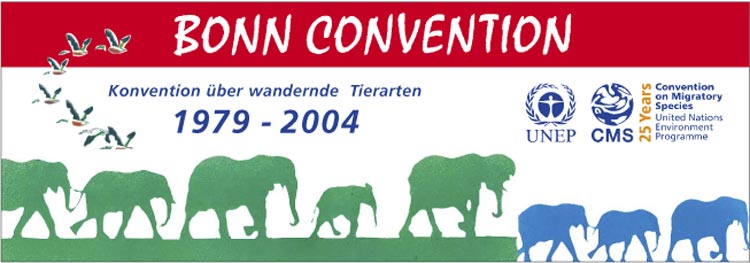Migratory Species: Linking Ecosystems and Disciplines
Workshop on the behalf of the 25th anniversary of the
Bonn Convention
Berlin: World of TUI Corporate Representation TUI AG
Unter den Linden 17, 10117 Berlin / GERMANY
Date: 22.06.-23.06.2004
The workshop celebrated the 25th anniversary of the Bonn Convention, reporting of
what has been achievend on how ecosystems are linked through migratory species,
on reasons why it is necessary to unite forces between NGOs, governmental organisations
and the united nations an on how new information technologies help conservationing.
Final Report (pdf) (224 pages, 42 MB)
You'll find all talks of the Workshop as PPS or as PDF.
Please take notice that some talks are really large documents!

Opening adress
[PDF]
Dr. Wolf Michael Iwand
"Let me conclude by saying that I expect that Tourism can act as an important
international multiplicator of the CMS for billions of tourists, destinations worldwide
and local communities as well stimulating the involvement of local businesses and developers.
The tourism industry can help to raise the rofile of the CMS globally and to support awareness
campaigns and capacity building throughout the spectrum along the migration routes –
specifically in developing countries. I wish the Bonn Convention a bright future, many
happy returns of this jubilee and sustaining results to come from this workshop."
http://www.tui.de
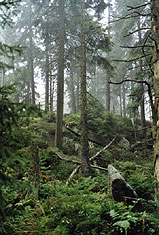
Europarc Deutschland
Dr. Eberhard Henne
In Germany there are 13 national parks, 14 biospere reserves and over 80 regional parks. Nature
protection is the responsibility of the federal sstates. Nature, however, is without borders.
There is therefore a need for coordination between the states. This role has been taken on by
the umbrella organization EUROPARC Germany (earlier known as FÖNAD), founded in 1991.
EUROPARC Germany provides a forum where the professionals in the large German protected areas
can work together to formulate common positions and carry out joint projects.
http://www.europarc-deutschland.de

The Conservation impact of CMS in tis first 25 years:
an overview
[PPS] [PDF]
Dr. Pierre Devillers
To maximise conservation impact there is close cooperation between the COP (Conference of the Parties,
every three years) and the scientific council coordinated through the secretariat. The conservation
emphasises the trans-borderd phenomena and the multi-lateral aspects. It plays a unique role in dealing
with the long distance movements of marine organisms much affected by risk factors operating in
international waters. Special agreements listed on appendix II are a unique feature of the convention,
providing a finished instrument especially taild to the needs of the respective animal group (EUROBATS,
AEWA, ASCOBANS, ACCOBAMS, Wadden Sea Seals).
http://www.naturalsciences.be/science/whoswho/whoswho/searcher_db/pierredevillers
Linking Ecosystems through Migratory Species
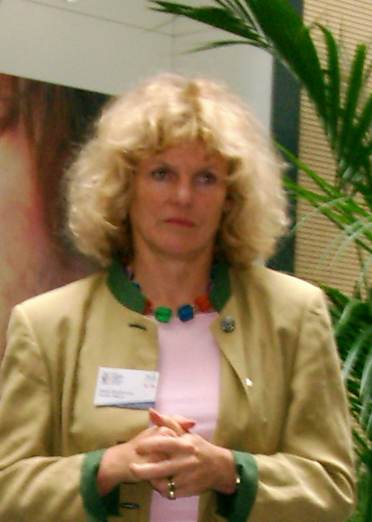
Protecting Sahelian Antelopes
[PPS] [PDF]
Dr. Roseline Beudels-Jamar
Summary will come soon.
http://www.naturalsciences.be/science/whoswho/whoswho/searcher_db/roseline-clairebeudels-jamar

Bukhara deer as a flag species for Aral sea basin ecosystems conservation
[PPS] [PDF]
Dr. Olga Pereladova:
Characteristics of ecosystems of Central Asia are given, which ensure conservation of unique biodiversity.
The main ecosystem of the river valleys - riparian forest, while the watershed as a whole is largely occupied
by a variety of desert types (e.g. sand, clay). Therefore riparian forests represent a unique land, which is
particularly suitable for agriculture, resulting in the destruction of natural ecosystems. As the river
valley is the most climatically comfortable area in the region, the majority of the population (up to 90%)
from each of the basin countries is concentrated within its limits. Existing system of irrigation not only
takes water for the fields, but prevents it from flooding floodplain forests, which causes their degradation.
It is not taken in consideration, that riparian forests are very important from the point of view of water
saving and soil erosion prevention. Riparian forests of major Central Asian rivers are crucial for
biodiversity conservation of the whole region.
http://www.panda.org/about_wwf/how_we_workgifts_to_the_earth/gift_detail.cfm?gift_id=763

Conserving migratory marine birds with the Bonn Convention and its daughter
agreements: sucesses to date and ways forward
[PPS] [PDF]
Dr. John Cooper:
The seabirds and marine shorebirds that are listed in CMS appendieces as well as those covered by its "daugther"
agreements, AEWA (African-Eurasian Waterbirds Agreement) and ACAP (Agreement on the Conservation of Albatrosses
and Petrels) were coverd. After looking at waht conservation measures have been proposed so far, and what
actions are now required, it is necessariliy to investigate the sea and marine shorebirds that are not coverd
by the CMS and its agreements from both a taxonomic and a geographicaö perspectives and endeavour to identify
those species that would benefit from inclusion in CMS appendieces and by either having agreements or memoranda
of understandig developed from them.
http://web.uct.ac.za/depts/stats/adu/staff/s_jc.htm/
http://www.ladbrokes.com/bigbirdrace/scienceProject.html
Uniting Forces for Nature: Complementing the
United Nations Instruments
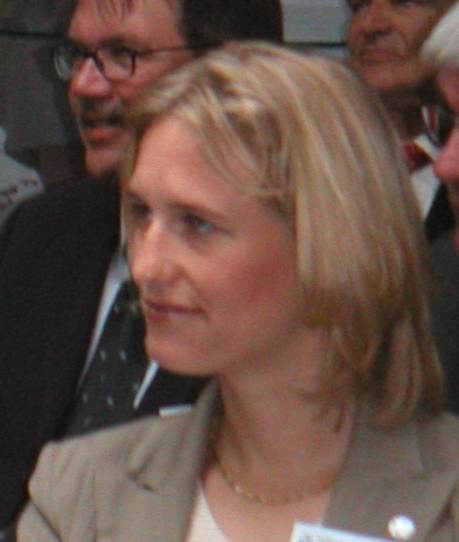
Chaos or Coherence? - Implementing and enforcing the conservation of migratory
species by different legal instruments
[PPS] [PDF]
Dr. Nele Matz:
Due to their routes of migration through different states, i.e. the so-called "range states", or through
different jurisdictional zones in the sea, migratory species are in a particular need of protection by
international co-operation. A number of different multilateral agreements are applicable to the conservation
of migratory species.
The only multilateral agreement that explicitly refers to the management and conservation of migratory species
is the Bonn Convention. Other conventions that explicitly refer to migrants are the Agreement relating to
the Conservation and Management of Straddling Fish Stocks and Highly Migratory Fish Stocks (Fish Stocks
Agreement) and regional conventions on a single migratory species e.g. the Inter-American Tropical Tuna
Convention. Other agreements with a global scope that are applicable to migratory species without explicitly
focusing on their conservation are the Convention on Biological Diversity, the Ramsar Convention and CITES.
Additionally, in Europe the Bern Convention in some articles explicitly mentions migratory species and the
Habitat and Birds Directives of the European Union also provide for some protection in a regional context.
If the scopes of the different agreements applicable to migratory species are compared it becomes apparent that
many species are listed in more than two of the annexes on particularly endangered species. As a consequence,
close co-operation between the different agreements is necessary to avoid a doubling of efforts and a waste
of resources. The need for closer co-operation is already reflected by a variety of memoranda of understanding
between the different secretariats but also with other international organisations and non-governmental organisations.
To improve collaboration in the future joint work programmes are recommended, since, in contrast to many
memoranda of understanding that only state the general will to collaborate, such programmes can achieve a mutual
reinforcement of efforts that enhances the effectiveness of conservation of migratory species.
Another element that is crucial for an effective conservation approach is the enforcement of conventions applicable
to the conservation of migratory species. Such mechanisms have to be a focus of regulatory frameworks. Of the
different mechanism that are known in international environmental law, financial mechanism are often considered a
particularly viable means for compliance assistance. However, many of the agreements mentioned in the context
of migratory species have no or only very limited financial means to provide for assistance.
http://www.mpil.de/personal/nmatz/index.html

Albania nature conservation, an experience from a developing country
[PPS] [PDF]
Zamir Dedej:
Summary will come soon.
http://www.s

Protecting Nature through Private-Public Partnership-the case for the conservation of common dolphins
[PPS] [PDF]
Chris Butler:
Summary will come soon.
www.wdcs.org
Improving Knowledge for Conservation:
the Contribution of New Technologies

Why Fish? An Example of Sucessful Usage of the Internet
[PPS] [PDF]
Dr. Rainer Froese:
FishBase (www.fishbase.org) is a large online
information system with key data on currently 28,500 species of fish. Usage of
FishBase on the Internet continuous to grow and stood at over 12 million hits from over
600,000 monthly visitors in May 2004 making fish more popular than birds or butterflies.
Most users enter the system through common names and look at species summary information
and at photos. But there is also substantial usage of the ‘specialist’ pages
which contain information on e.g. population dynamics, taxonomy, trophic ecology, reproduction
or genetics. More than 1,500 fish species are migratory in the sense of undertaking regular
migrations of more than 100 km; many more species regularly cross international boundaries.
Most migratory fishes are used commercially and several are threatened by extinction. Migratory
fishes tend to be larger than non-migratory fishes. FishBase coordinator
Rainer Froese (rfroese@ifm-geomar.de) calls on the CMS community to assist in keeping
FishBase up to date by sending copies of relevant publications and data sets. He stresses
that for many data regularly collected by CMS researchers FishBase can act as a permanent archive.
http://www.ifm.unikiel.de/fb/fb3/fi/staff/rfroese.html

The Fourth Dimension: Overview of Altitudinal Migration
[PPS] [PDF]
Stefan Kreft:
Altitudinal migration is shown to be a widespread and ecologically important, but little studied migratory
behaviour. It principally includes the shift of a montane population downslope after reproduction and upward
before the next breeding season. Many movements may be linked to food resource dynamics, but other factors
seem understudied. Between taxa, there is a lot of variation with respect to altitudinal intervals and
distances crossed and differential involvement of males, females and young individuals. Four studies of
tropical bird communities identified 21-51 % of (mostly forest-based) altitudinal movers, with many unknown
cases suspected. The ranges of altitudinal migratory populations are typically small, linear and disjunct.
These characteristics make them vulnerable to direct or indirect negative impacts, e.g., climate change.
Therefore, altitudinal forest corridors must be established.
http://www.fan-bo.org

High wintering site fidelity of a boreal-netropical migrant an opportunity for
expanding the latitudinal frontier of stable isotope analysis in New World
[PPS] [PDF]
Dr. Sebastian K. Herzog:
Summary will come soon.
http://www.vogelwarte-helgoland.de/

Satellite and remote-sensing data for the identification
[PPS]
Birgit Gerkmann:
During a one-year stay in Santa Cruz, Bolivia, she worked on her diploma thesis about problems of
biodiversity conservation in Bolivia caused by the expanding oil industry. Adjacently she worked with
Geograhical Systems within the project "Global Register of Migratory Species"
(www.groms.de). In 2003 she started her PhD thesis at the
Alexander Koenig Research Insitute in Bonn about application of satellite telemetry and remote sensing
technology for the conservation of migratory birds.
http://www.groms.de/

Lessons from recent telemetric studies: oceanic movements of leatherback
turtles and interaction with open-water fisheries
[PPS] [PDF]
Dr. Jonathan D.R. Houghton:
The overall extent of habitat use by leatherback turtles (Dermochelys coriacea) in the North Atlantic,
and hence their possible interactions with
longline fisheries, is unknown. Long-term satellite telemetry data were used
to reveal that leatherbacks range throughout the North Atlantic, indicating
that closing limited areas to longline fisheries will probably have only partial
success in reducing turtle by-catch. Although turtles dive very deeply on occasion
(one descended to a maximum depth of 1,230 metres, which represents the deepest
dive ever recorded for a reptile), they generally restrict their diving to less
than 250 metres, which increases the chance that they will encounter longline hooks.
In the short term, by-catch rates might be reduced through the basin-wide adoption
of alternative hook and bait types used in long line fisheries, although rates of
mortality may still remain too high to prevent eventual population decline.
http://www.turtle.ie
http://www.swan.ac.uk/bs/turtle

The Global Registry of Migratory Species - GROMS
[PPS] [PDF]
Dr. Klaus Riede:
Migratory species are an important dynamic component of biodiversity. The conservation and protection of
these species requires international cooperation. However, the level of knowledge we have is not sufficient
and information is immensely scattered. Today we can only estimate the number of migratory species within
a vast range of 5000 and 10000. GROMS consolidates and summarises all available information and the current
states of knowledge into a relatinal database. It supports a Geographic Information System (GIS) interface
and permits various search options for novice users and for experts. The GROMS database is structured to
provide an additional tool for fact finding and decision-making by the CMS bodies and related regional
Agreements as well as the Convention on Biological Diversity. To this effect, the database is designed to
supply information on migratory species, their distribution map, population and bibliography. The current
multilingual database contains 4,344 migratory species, with their threat and protection status
(International Red List), protection status (after CMS and CITES) as well as migration types and more than
5,500 literature citations. Query tools allow to combine different search criteria and, for example, generate
listing of species protected by both CITES and CMS, or not protected at all. The database is available at
http://www.groms.de, but also on CD-ROM (part of the GROMS book). While
bird migration is relatively well investigated, mammal, fish and insect migrations are known only for few
economically important species. So far distribution maps in GIS format have been produced for 1,174 species
at a global scale. Hence, intersection with environmental data as well as arbitrary scale adjustment and
protection is possible. In co-operation with the Geographic Institute of the University of Bonn, the GIS data
are also provided as interactive maps in the World Wide Web. This includes a software for animated visualisation
of satellite tracks.
An extensive threat analysis published as a book (Riede 2001) shows that a higher number of migratory sea birds
aand fishes that are endangered, but not yet sufficiently protected by the Bonn Convention.
http://www.groms.de/data/riede/riede.html

20.000 km from Mark Brandenburg to South Africa: Migrations of Raptors as revealed by satellite
telemetriy
[PPS] [PDF]
Prof. Dr. Bernd-Ulrich Meyburg:
Summary will come.
http://www.raptors-international.de/

Albatrosses, penguins, wahles and turtles: wanderer of the oceans
[PPS] [PDF]
Prof. Dr. Boris Culik:
Summary will come soon.
http://www.meeresforschungonline.de/meteor.htm
http://www.fh3.de/kontakt/kontakt.htm
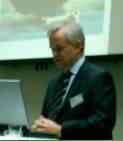
The Seals Agreement
[PPS] [PDF]
Jens Enemark:
The trilateral Agreement was concluded between Denmark, Germany and the Netherlands on 16 October 1990 in
Bonn, Germany, and entered into force one year later. The aim of the Agreement is to promote close
cooperation amongst the Parties in order to achiev and maintain a favourable conservation status for the
Common seal population, which is an irreplaceable component of the Wadden Sea and an important indicator
of its environmental health.
http://www.waddensea-secretariat.org
|
